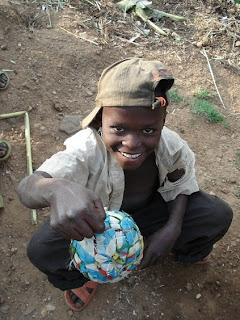
Much of my research is about displacement and thus I spent a lot of time in villages that are especially affected by displacement (read: in-migration). This picture tells a lot. Many displaced people first stay for a month or two with a host family in the receiving village. However, when it becomes clear that the security situation at home is unlikely to improve the displaced want to build their own homes. So either the chief assigns a piece of land for the displaced to build their house (exactly how to build one of these houses is an upcoming post), or the host family gives a small piece of land where the displaced can build their house. The host family owns the building on the left and right, but in the space between the displaced family was allowed to build their house.

A common sight. Most motorbike-drivers only have a little petrol in their bikes because patrol is expensive ($2 a litre here, and quickly a multiple of that in more remote areas of Congo). And as a result they often run out of patrol. This was my driver trying to use his very last bit of petrol to get the motor going. I decided to walk.

Wanna play ball?

So the idea was that I would teach them how to count from 1 to 10 in English. However they taught me how to count from 1 to 10 in Swahili. I am studying Swahili at the moment and thought that I knew how to do that. Not really, because my books are Tanzanian Swahili. The number "9" is "tisa" in Tanzanian Swahili but "kenda" here in Congo (which has a Bantu origin).

Pygmees are discriminated against in the Congo. We worked in a village that was close to a Pygmee village (a village of displaced Pygmees actually) and the guys, when seeing this, were joking that "this is to keep Pygmees from running away". It actually is for porks.
No comments:
Post a Comment